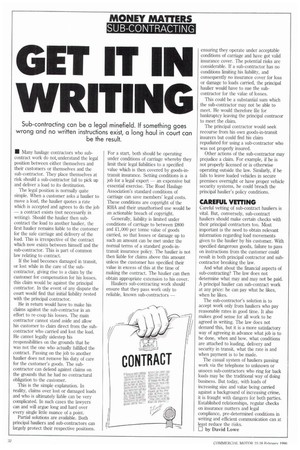GET IT IN WRITING
Page 34

If you've noticed an error in this article please click here to report it so we can fix it.
Sub-contracting can be a legal minefield. If something goes wrong and no written instructions exist, a long haul in court can be the result.
• Many haulage contractors who subcontract work do not, understand the legal position between either themselves and their customers or themselves and the sub-contractor. They place themselves at risk should a sub-contractor fail to pick up and deliver a load to its destination.
The legal position is normally quite simple. When a customer asks a haulier to move a load, the haulier quotes a rate which is accepted and agrees to do the job — a contract exists (not necessarily in writing). Should the haulier then subcontract the load to another haulier, the first haulier remains liable to the customer for the safe carriage and delivery of the load. This is irrespective of the contract which now exists between himself and the sub-contractor. This is part of common law relating to contract.
If the load becomes damaged in transit, or lost while in the care of the subcontractor, giving rise to a claim by the customer for compensation for his losses, this claim would be against the principal contractor. In the event of any dispute the court would find that initial liability rested with the principal contractor.
He in return would have to make his claims against the sub-contractor in an effort to re-coup his losses. The main contractor cannot stand aside and allow his customer to claim direct from the subcontractor who carried and lost the load. He cannot legally sidestep his responsibilities on the grounds that he was not the one who actually folfilled the contract. Passing on the job to another haulier does not remove his duty of care for the customer's goods. The subcontractor can defend against claims on the grounds that he had no contractural obligation to the customer.
This is the simple explanation. In reality, claims over lost or damaged loads and who is ultimately liable can be very complicated. In such cases the lawyers can and will argue long and hard over every single little nuance of a point.
Partial solutions are available. Both principal hauliers and sub-contractors can largely protect their respective positions. For a start, both should be operating under conditions of carriage whereby they limit their legal liabilities to a specified value which is then covered by goods-intransit insurance. Setting conditions is a job for a legal expert — an expensive but essential exercise. The Road Haulage Association's standard conditions of carriage can save members' legal costs. These conditions are copyright of the RHA and their unauthorised use would be an actionable breach of copyright.
Generally, liability is limited under conditions of carriage to between 2800 and £1,000 per tonne value of goods carried, so that losses or damage up to such an amount can be met under the normal terms of a standard goods-intransit insurance policy. The haulier is not then liable for claims above this amount unless the customer has specified their value in excess of this at the time of making the contract. The haulier can then obtain appropriate extension to his cover.
Hauliers sub-contracting work should ensure that they pass work only to reliable, known sub-contractors — ensuring they operate under acceptable conditions of carriage and have got valid insurance cover. The potential risks are considerable. If a sub-contractor has no conditions limiting his liability, and consequently no insurance cover for loss or damage to loads carried, the principal haulier would have to sue the subcontractor for the value of losses.
This could be a substantial sum which the sub-contractor may not be able to meet. He would therefore file for bankruptcy leaving the principal contracor to meet the claim.
The principal contractor would seek recourse from his own goods-in-transit insurers but could find his claim repudiated for using a sub-contractor who was not properly insured.
Other actions of the sub-contractor may prejudice a claim. For example, if he is not properly licensed or is otherwise operating outside the law. Similarly, if he fails to leave loaded vehicles in secure premises overnight or have proper vehicle security systems, he could breach the principal haulier's policy conditions.
CAREFUL VETTING
Careful vetting of sub-contract hauliers is vital. But, conversely, sub-contract hauliers should make certain checks with their principal contractors too. Most important is the need to obtain relevant information regarding load movements given to the haulier by his customer. With specified dangerous goods, failure to pass on instructions from the customer could result in both principal contractor and subcontractor breaking the law.
And what about the financial aspects of sub-contracting? The law does not determine what may and may not be paid. A principal haulier can sub-contract work at any price: he can pay what he likes, when he likes.
The sub-contractor's solution is to accept work only from hauliers who pay reasonable rates in good time. It also makes good sense for all work to be agreed in writing. The law does not demand this, but it is a more satisfactory way of agreeing in advance what job is to be done, when and how, what conditions are attached to loading, delivery and security in transit, what the rate is and when payment is to be made.
The casual system of hauliers passing work via the telephone to unknown or unseen sub-contractors who ring for back loads may be the traditional way of doing business. But today, with loads of increasing size and value being carried against a background of increasing crime, it is fraught with dangers for both parties. Established relationships, regular checks on insurance matters and legal compliance, pre-determined conditions in writing and efficient communication can at least reduce the risks.
LI by David Lowe
















































































































































































